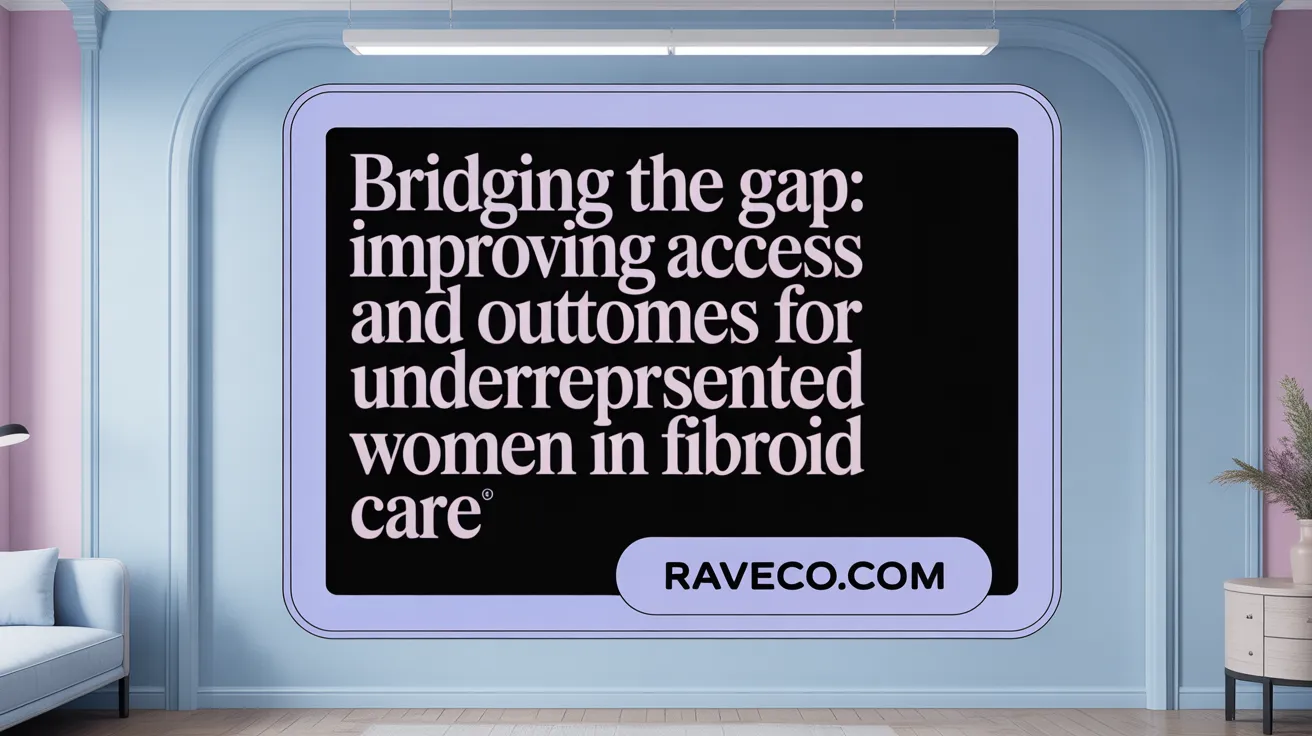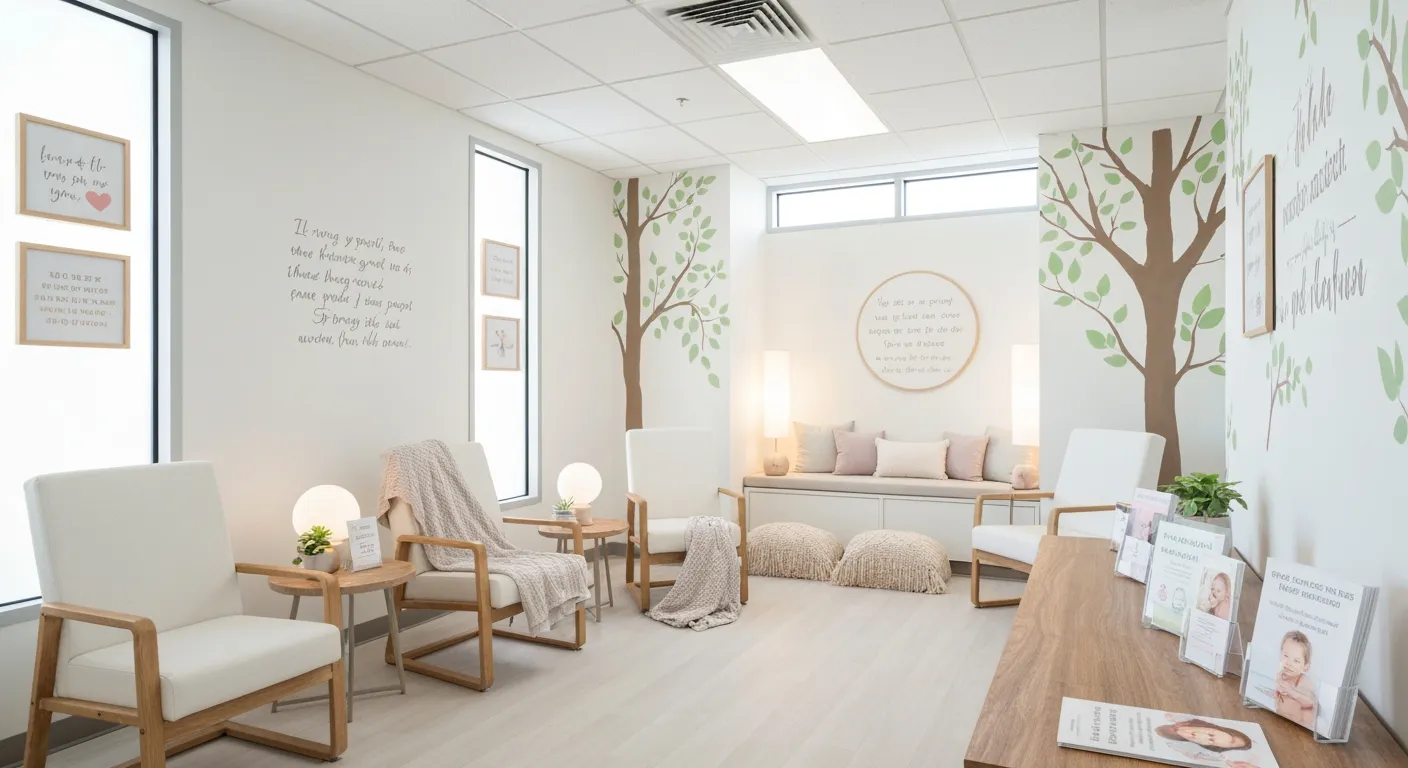Comprehensive Wellness: Embracing Nutrition, Exercise, and Emotional Health in Pregnancy

Understanding Uterine Fibroids and Their Impact on Women's Lives
Prevalence and Symptoms of Uterine Fibroids
Uterine fibroids are noncancerous tumors commonly developing in or around the uterus, affecting up to 80% of women by age 50. These growths are particularly prevalent among Black women, who face a threefold increased risk and often experience earlier onset with more severe symptoms. Fibroids can vary greatly in size, from as small as a seed to as large as a watermelon, and they may grow within the uterine wall, inside the uterine cavity, or on the outer surface.
Common symptoms include heavy and prolonged menstrual bleeding, pelvic pressure, chronic pelvic pain, frequent urination, pain during intercourse, and bowel or bladder complaints. Larger fibroids may cause bloating or abdominal protrusion, and in some cases, they impact fertility and pregnancy outcomes.
Impact on Quality of Life and Fertility
Fibroids can significantly disrupt daily life due to heavy bleeding leading to anemia, pelvic discomfort, and emotional distress, including mood swings and sexual disturbances. These symptoms often cause women to limit activities and affect overall well-being.
Regarding fertility, submucosal fibroids, which grow within the uterine cavity, can reduce pregnancy chances by up to 50% and double miscarriage risks. Fibroids may also complicate pregnancy, increasing risks of miscarriage, preterm delivery, and operative births like cesarean sections.
Common Misconceptions and Delays in Seeking Care
Many women initially interpret fibroid symptoms as normal "feminine issues" and may hesitate to seek medical help. Additionally, dismissive healthcare experiences, long wait times, travel distances, and healthcare costs can delay timely diagnosis and management.
The internet serves as a primary source of information for many women, emphasizing the importance of reliable online resources and improved health literacy. Increasing awareness through patient-centered communication and community outreach is vital, especially to support minority and rural populations.
Understanding that fibroids are common but not "normal" and advocating for attentive medical care can lead to earlier intervention and improved quality of life.
The Spectrum of Non-Surgical Treatments for Fibroids
What Medical Therapies Are Available for Fibroid Management?
Medical treatments often serve as first-line options to manage fibroid symptoms, particularly heavy menstrual bleeding and pain. Hormonal therapies include oral contraceptive pills, progestins, and levonorgestrel intrauterine devices (IUDs), which control bleeding but do not reduce fibroid size. Gonadotropin-releasing hormone agonists (GnRH agonists) such as Lupron and Synarel induce a temporary menopause-like state, reducing fibroid and uterine volume by about 50% over three months. These are typically used short-term to alleviate symptoms or improve anemia before surgery, given potential side effects like bone loss. For detailed information, see Medical treatments for fibroids and Nonsurgical fibroid treatments.
Which Minimally Invasive Procedures Provide Effective Fibroid Relief?
Uterine Fibroid Embolization (UFE): This outpatient, catheter-based procedure blocks blood supply to fibroids, causing them to shrink by 30-50%. It is suitable for treating multiple or larger fibroids without abdominal incisions. Recovery is generally quick, around 5-10 days. However, some women may experience amenorrhea and up to 20% might require further treatment within five years. More on this can be found at Uterine fibroid embolization procedure and Uterine Fibroid Embolization at NYU Langone.
Transcervical Radiofrequency Ablation (Sonata): A minimally invasive, incision-free method that uses ultrasound and radiofrequency energy to shrink fibroids up to 5 cm in size. Patients can typically resume normal activities swiftly, and pregnancy after treatment is possible, although more clinical data is awaited. Explore Transcervical Radiofrequency Ablation (Sonata) and Nonsurgical Fibroid Treatments at NYU Langone.
MRI-Guided Focused Ultrasound (FUS): This non-invasive procedure uses focused high-frequency sound waves to destroy fibroids under MRI guidance. It allows rapid recovery but has limitations regarding long-term efficacy and fertility preservation. See more at MRI-guided focused ultrasound for fibroids.
What Are the Advantages and Limitations of These Treatments?
Non-surgical options offer significant benefits, including shorter recovery times, lesser pain, preservation of the uterus, and outpatient settings avoiding general anesthesia. They are especially important for women aiming to maintain fertility or seeking alternatives to major surgery. However, limitations exist. Medical therapies may only provide temporary symptom relief and do not shrink fibroids permanently. Minimally invasive procedures might not be suitable for all fibroid types or sizes, carry risks such as potential recurrence, and their long-term effects on fertility still require further study. Careful patient counseling and personalized treatment plans are essential. For comprehensive insights, refer to Non-surgical management of uterine fibroids and Fibroid Treatment Collaborative.
Which advanced technologies are used in modern obstetrics and gynecology to enhance women's health care?
Modern obstetrics and gynecology utilize advanced technologies like robotic-assisted surgeries in gynecology for minimally invasive treatment. For fibroids, non-surgical innovations include Uterine Fibroid Embolization (UFE), Transcervical Radiofrequency Ablation (Sonata), and MRI-guided Focused Ultrasound (FUS), enhancing patient outcomes with less downtime. Digital health tools and high-resolution imaging support accurate diagnosis and tailored care planning, particularly in centers around Queens, NY. Resources on fibroid care in Queens and advanced treatments include Fibroid Specialists in Astoria Queens, Fibroid Care in Queens NY, and Fibroid Treatment Collaborative. Additional details on technology use in fibroid care at major centers can be found at Mount Sinai Fibroid Care and NewYork-Presbyterian Fibroid Treatment.
Patient Experiences and Reflections on Managing Fibroids Without Surgery

Patient stories highlighting symptom relief and quality of life improvements
Many women living with uterine fibroids share stories of significant relief and improved daily living following non-surgical fibroid treatments. Patients report reduced heavy bleeding, diminished pelvic pain, and less pressure and discomfort, which markedly enhance their quality of life. Several have experienced rapid and mostly painless recoveries from procedures like Uterine Fibroid Embolization (UFE) or transcervical radiofrequency ablation, allowing them to resume normal activities within days to weeks. Patient life improvements after fibroid treatment are well documented in fibroid treatment collaborative patient stories.
Emotional and psychological aspects of fibroid symptoms
Fibroid symptoms can profoundly affect emotional and psychological well-being. Women frequently experience mood swings, emotional distress, and sexual health disturbances related to physical discomfort and chronic symptoms such as those described in psychological effects of fibroids. The stress of managing pain and the impact on fertility and sexual function may contribute to anxiety and reduced overall mental health. Sharing their journeys and receiving compassionate care often provide emotional support and empower women toward healing, as highlighted in personal accounts like Dawn's fibroid diagnosis and coping story.
Importance of patient-centered care and shared decision-making
Patient-centered approaches are critical in fibroid management. Women value clear communication, empathy, and inclusion in treatment planning, ensuring their individual goals and fertility desires are understood and prioritized. Providers specializing in fibroids emphasize shared decision-making, using personalized care plans and educational resources to help patients navigate options from hormonal therapies to minimally invasive procedures, as discussed in patient-centered fibroid care and shared decision-making. This collaborative spirit fosters trust and better alignment of care with patients' needs and life plans, in line with recommendations from fibroid specialists in Queens NY and multidisciplinary treatment teams like those at NYU Langone Center for Fibroid Care.
How Personalized, Woman-Led Care Improves Fibroid Management Outcomes

Role of woman-led healthcare providers in Queens, NY
Woman-led healthcare providers specializing in obstetrics and gynecology in Queens, NY, such as Viva Eve in Astoria, offer a comprehensive range of services that include fibroid care, prenatal and postnatal support, gynecological exams, hormone therapy, and minimally invasive procedures. The teams often comprise board-certified specialists skilled in both surgical and nonsurgical fibroid treatments at NYU Langone, ensuring women access expert care close to home.
Advantages of personalized care in women's health
Seeking care from a woman-led provider comes with distinct advantages. These providers tend to create a more empathetic and comfortable environment where women feel encouraged to discuss sensitive reproductive health concerns openly. Personalized care approaches help shape treatment plans that consider a woman’s lifestyle, medical history, and treatment goals, leading to better communication, trust, and patient satisfaction as highlighted in the Fibroid Treatment Collaborative.
Comprehensive gynecological and fibroid services offered
These providers offer advanced diagnostics like ultrasounds and minimally invasive treatments suited to individual needs—ranging from hormonal therapies and Uterine Fibroid Embolization (UFE) to transcervical radiofrequency ablation and robotic-assisted surgeries in gynecology. Many also emphasize fertility preservation and symptom management, tailoring care based on fibroid size, location, and reproductive aspirations as described by NYU Langone Center for Fibroid Care.
Emphasis on compassionate patient-provider communication and empowerment
Compassionate communication and shared decision-making are critical components of care, empowering women to understand their condition and treatment options. Educational resources, support groups, and community outreach are also prioritized to raise fibroid awareness, particularly in underserved populations. This collaborative care model leads to improved treatment adherence, quicker recovery, and enhanced quality of life for women with fibroids as supported by Fibroid Treatment Collaborative patient stories.
Addressing Disparities and Enhancing Accessibility in Fibroid Care

Racial and socioeconomic disparities affecting fibroid diagnosis and treatment
Uterine fibroids disproportionately impact Black women, who face a threefold increased risk compared to other groups. This population often experiences earlier onset and more severe symptoms, such as heavy bleeding and pain, which can significantly impair daily life. Socioeconomic factors like insurance coverage, income level, and geographic location further complicate timely diagnosis and effective treatment.
Barriers faced by Black women and rural populations
Black women and those living in rural parts of Indiana and other areas encounter unique obstacles, including dismissive healthcare experiences, long wait times, high costs, and limited access to specialized OB-GYN services (OB-GYN access in rural Indiana). These barriers frequently result in delayed care and untreated symptoms, which may worsen fibroid-related complications.
Local accessibility of advanced fibroid treatments in Queens, NY
Queens, NY, benefits from local healthcare providers such as Fibroid Specialists in Astoria Queens at Viva Eve and Fibroid Treatment in Jamaica Queens at USA Fibroid Centers offering advanced, minimally invasive treatment approaches. Services include uterine fibroid embolization (UFE), nonsurgical therapies, and surgical options tailored to individual needs. These centers accept major insurance plans, enhancing accessibility for a broad patient base.
Insurance coverage and community outreach importance
Insurance partnerships by local clinics facilitate broader access to care. Further, educational campaigns, patient-centered communication, and community outreach focusing on fibroid awareness and education especially target minority and underserved groups. Such efforts empower women to seek earlier diagnosis and engage in shared decision-making in fibroid care, improving overall outcomes in Queens and similar communities.
Navigating Fertility and Symptom Management Without Surgery

Considerations for Women Wishing to Preserve Fertility
Many women with uterine fibroids prioritize fertility preservation when choosing treatment options. Fibroids can affect fertility by disrupting the uterine lining or causing recurrent miscarriage. Treatments that avoid removing the uterus, such as myomectomy or minimally invasive therapies, are typically favored. Decisions are personalized based on fibroid size, location, symptoms, and reproductive goals, with patient-centered discussions essential for shared decision-making in fibroid care.
Non-Surgical Options Suitable for Symptom Control and Fibroid Reduction
Several effective non-surgical treatments exist to manage fibroid symptoms and reduce fibroid size without surgery. Gonadotropin-releasing hormone agonists (GnRH agonists) can shrink fibroids by about 50% over three months by inducing a temporary menopause-like state. GnRHa medications like Lupron, Synarel, Zoladex are examples. Uterine fibroid embolization (UFE), a minimally invasive procedure, blocks blood flow to fibroids causing them to shrink by 30–50%, easing symptoms like heavy bleeding and pelvic pain. Transcervical radiofrequency ablation (Sonata) uses ultrasound waves and radiofrequency energy to target fibroids up to 5 cm in size with no incisions. These approaches allow quick recovery and can be suitable for women wishing to conceive or avoid surgery. Oral contraceptives and tranexamic acid help control bleeding but do not reduce fibroid size.
Long-Term Outcomes and Patient Counseling
While non-surgical treatments improve quality of life and symptom management, some may have limitations. For instance, Uterine fibroid embolization (UFE) has a recurrence rate, and up to 20% of women may require additional treatment within five years. GnRH agonists are generally short-term due to side effects like bone loss. Fertility outcomes post-procedure vary; for example, radiofrequency ablation may allow pregnancy, but more research is needed. Comprehensive counseling about benefits, risks, and expected recovery fosters informed choices and realistic expectations. For patient stories and multidisciplinary care perspectives, see the Fibroid Treatment Collaborative.
Importance of Early Diagnosis and Proactive Care
Early recognition of fibroid symptoms encourages timely evaluation and treatment, improving outcomes and preserving fertility when desired. Women often delay seeking care, mistaking symptoms as normal menstrual changes. Awareness campaigns, improved health literacy, and better access to specialized gynecologic care, especially in underserved areas like rural Indiana, are critical. Regular gynecologic screenings, ultrasound, and patient education enable proactive monitoring, symptom relief, and individualized care planning. Explore more on Uterine fibroids prevalence and healthcare barriers and the role of OB-GYN access in rural Indiana.
Empowering Women Through Non-Surgical Fibroid Care
Non-Surgical Treatment Options for Fibroids
Women seeking alternatives to surgery have several effective non-invasive treatments available. These include:
- Uterine Fibroid Embolization (UFE): A minimally invasive procedure blocking blood flow to fibroids, causing them to shrink with quick recovery.
- Transcervical Radiofrequency Ablation (Sonata): Uses ultrasound and radiofrequency energy to reduce fibroid size without incisions.
- Hormonal Therapies: Such as GnRH agonists, oral contraceptives, and IUDs, which manage symptoms like heavy bleeding.
- Endometrial Ablation: A heat-based outpatient procedure reducing heavy menstrual bleeding, suited for women not seeking future pregnancy.
Personalized, Woman-Led Care
Centres like Viva Eve in Queens offer patient-centered, women-led teams providing empathetic, tailored care. This approach enhances communication, respects individual goals—such as fertility preservation—and supports informed decision-making. Patient stories highlight substantial improvements in quality of life through such comprehensive care.
Early Diagnosis and Informed Discussions
Awareness of fibroid symptoms and early medical consultation are crucial. Women are encouraged to seek evaluation promptly to explore non-surgical options aligned with their health and fertility plans. Reliable health literacy and trusted provider partnerships empower women to navigate treatment confidently and effectively.




.png)